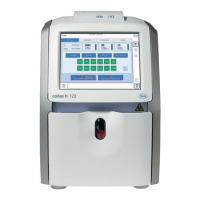Roche Diagnostics
Instructions for Use · Version 13.0 99
cobas b 123 POC system 4 Theoretical foundations
Parameters and calculations
BE
The base deviation of blood determines the titratable base of the blood. Theoretically,
this is measured by titrating blood with a strong acid or base to a pH = 7.4 with PCO
2
= 40 mmHg at 37 °C.
[1]
Unit: [mmol/L]
Equation 4-7
u BE
act
(p. 108)
BE
ecf
The base deviation of extracellular fluid determines the non-respiratory components
of the acid-base balance.
[1]
Unit: [mmol/L]
Equation 4-8
BB
The buffer base is the concentration of buffering anions, which is available in whole
blood, to buffer strong acids and consists mainly of protein anions and bicarbonate.
Of the protein anions, hemoglobin is the most significant.
[2]
Unit: [mmol/L]
Equation 4-9
SO
2
The quantity of oxyhemoglobin in the blood in proportion to the quantity of
hemoglobin in the blood that can bind to oxygen.
[1]
Unit: [%]
Equation 4-10
SO
2
(c)
q
Measured SO
2
has a higher priority than the calculated SO
2
(c). Calculating SO
2
(c) requires
pH, PCO
2
, and PO
2
values, and input value, Age (a/f).
The quantity of oxyhemoglobin in the blood in proportion to the quantity of
hemoglobin in the blood that can bind to oxygen.
[1]
()()
]HCO8.247.4pH7.7tHb1.43[tHb)0.014(1BE
3
−
+−−⋅+⋅⋅⋅−= c
()
−
+−−⋅=
3ecf
HCO8.244.7pH2.16BE c
⋅

